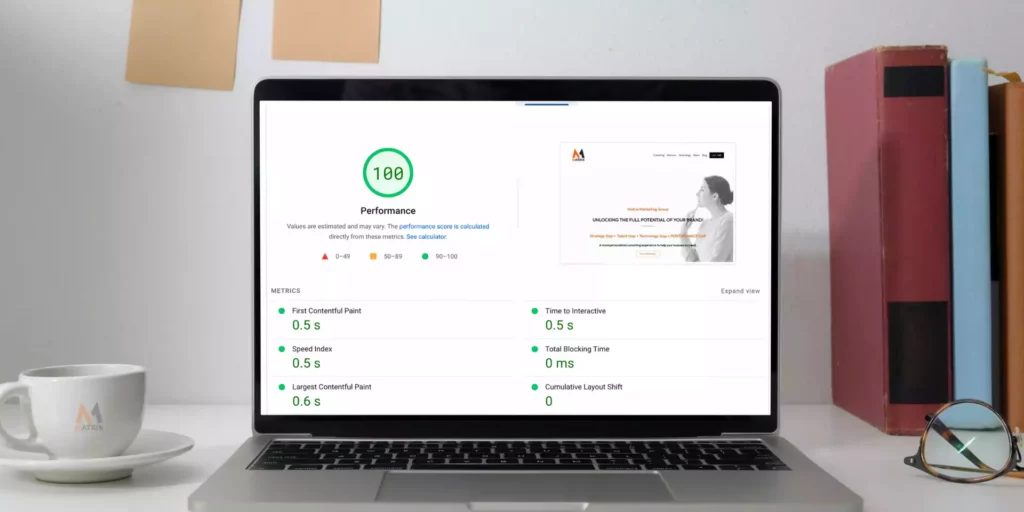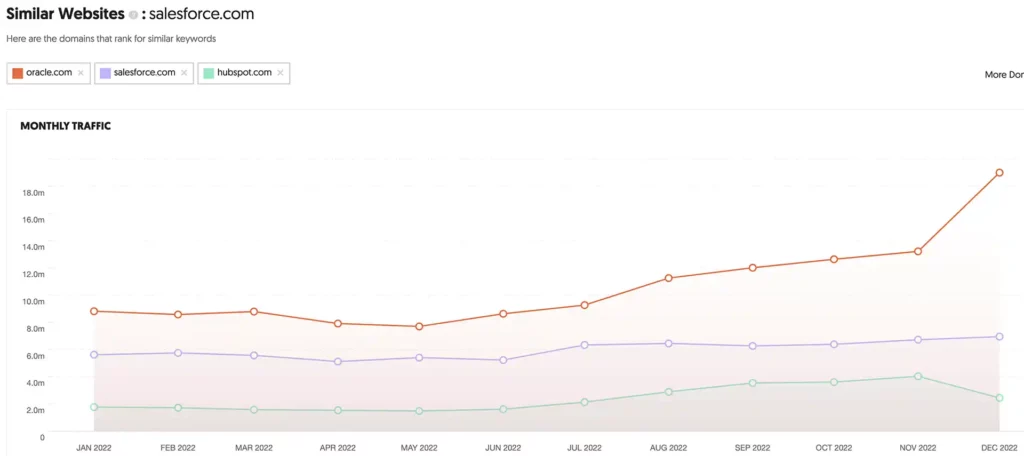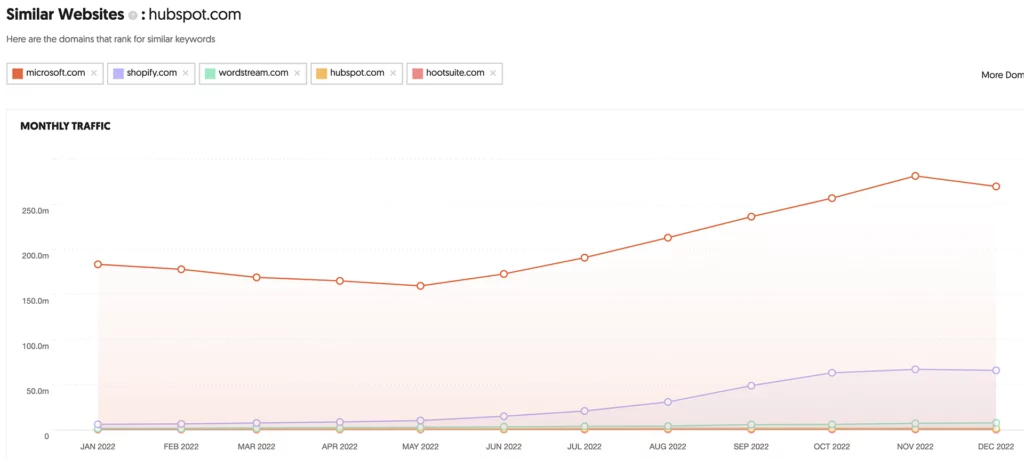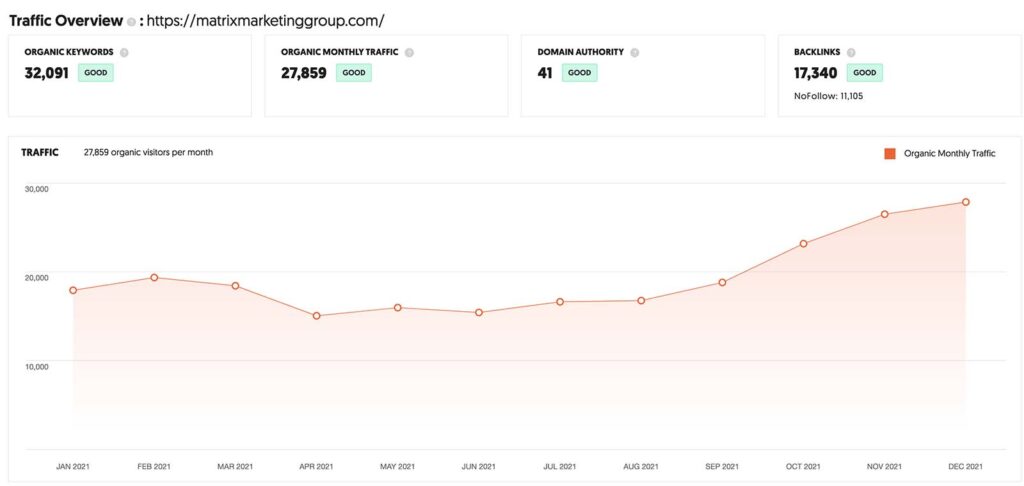7 Keys to a Successful Lead Generation Website
Learn the 7 Keys to a Successful Lead Generation Website.
Having a website is one of the most important steps in establishing an online presence for your business. But it’s not enough to have a website; you must also ensure that it meets its primary objective, lead generation. Lead generation involves attracting and converting visitors into qualified leads that can be nurtured and converted into customers.
This blog post will outline strategies for successful lead generation, such as creating high-quality content, optimizing search engines, and utilizing social media platforms. You will learn how to create a lead generation website that produces leads.
We’ll discuss how HubSpot Marketing Hub can help create a performance website with powerful tools designed specifically for lead generation purposes.
Are you looking for ways to increase leads on your website?
Lead generation is one of the primary objectives of having a website. It involves attracting and converting visitors into qualified leads that can be further nurtured to become customers. This blog post will outline strategies for successful lead generation, such as creating high-quality content, optimizing search engines, and utilizing social media platforms.
You won’t have to worry about missing out on potential customers or wasting time with ineffective tactics. With these tips and tricks in hand, you’ll be able to create an effective lead-generation strategy that will help you reach more potential customers than ever!
Building a lead generation website is not a simple tasks. Sure grab a template that gets you stuck in the mud later. You want a clean code site.

Read this article now and learn how HubSpot Marketing Hub can help create a performance website with powerful tools designed specifically for lead generation purposes!
What are the characteristics of a poor-performance website?

Characteristics of a poor-performance website include slow loading times, a cluttered and difficult-to-navigate design, inadequate content optimization for search engines, outdated code or plugins that don’t support the latest technologies, lack of mobile responsive design, and minimal to no use of analytics tools.
Poor-performance websites often fail to convert visitors into leads due to these factors. In addition, they can also lead to higher bounce rates as users quickly abandon the site out of frustration with its lack of functionality.
How do you know if your website is ranking poorly?
You can check if your website is ranking poorly by checking its search engine rankings. If it is not appearing on the first page of a relevant search query or is further down the list than you would like, it could indicate that your website’s ranking is low.
Additionally, analyzing metrics such as bounce rate and time on the page can help determine if your visitors are having a good experience with your website and staying around long enough to take desired actions. This will help identify where optimization may be needed to improve performance.
How can you measure the success of your lead-generation efforts?
You can measure the success of your lead-generation efforts by analyzing metrics such as website visits, page views, conversions, and contact form submissions. Additionally, tracking how often leads engage with content or reach out to salespeople will give insight into your strategy’s success.
Using HubSpot Marketing Hub’s reporting features to monitor website performance and track lead generation goals over time will better understand what tactics are working best for you and which ones need improvement.
2022 about poor-performing website metrics
By 2022, poor-performing website metrics will be even more significant due to the rise in mobile device usage and the prevalence of search engine optimization (SEO). Metrics such as page loading times, bounce rate, and time on page will become increasingly important for website owners looking to generate leads.
In 2022, the average site loading speed was expected to be 1.5 seconds or less. Sites that take up to three seconds to load will likely suffer from higher bounce rates and lower conversions. Additionally, pages with large images or videos may take longer and should be optimized for mobile devices.
Websites with a high bounce rate—defined as visitors exiting the site without taking any action—are likely to experience fewer leads generated from their traffic. In 2022, sites were expected to have a bounce rate of less than 40%, while those with a rate above 50% may need improvement to convert more visitors into leads.
Time on page is another key metric for lead generation. While there is no hard-and-fast rule for how long someone should stay on a web page before converting into a lead, pages that keep visitors engaged for at least two minutes, tend to get better results than those where people abandon quickly after visiting just a few seconds.
SEO performance was becoming increasingly important for lead generation in 2022. Sites not optimized for search engines can need help attracting enough organic traffic. Relevant keywords and phrases should be used throughout the content, and titles should also incorporate them; this will help improve ranking in search engine results and help attract qualified leads actively searching for what the site offers.
What are the main challenges for CMOs and website design?
The main challenges for CMOs and website design are creating high-quality content that is optimized for search engines, utilizing the latest trends in marketing technology to capture leads, making sure that their website is mobile-friendly and loads quickly, ensuring their website has a low bounce rate so that visitors stay engaged with the site longer, tracking lead generation goals over time using reporting software such as HubSpot Marketing Hub’s features, and leveraging SEO to increase organic traffic.
Additionally, they must ensure an effective strategy for capturing leads once users land on the site. This requires specific tactics such as offering valuable resources or providing contact information so visitors can connect with salespeople.
Step-by-step instructions on how to create a lead-generation website

Step 1: Marketing research about your target audience, industry, personas, pains, and net gains.
Your marketing research is the first step to creating a successful lead-generation website. This research should include learning about your target audience, industry, personas, pains, and net gains.
To start with your target audience research, you need to determine who it is that you want to target with your website and what their needs are so that you can create relevant content for them. It would help if you also considered the industry trends and changes to keep up with the latest technological developments or customer preferences.
Personas are an effective tool for understanding how different types of customers interact with websites and make decisions based on their user experience.
Personas provide valuable insights into how users think, feel and behave when they visit a website or use an app; this knowledge can help marketers customize content or design elements accordingly to increase conversions.
You must research pain points (or areas where potential customers are having difficulties) as well as net gains (the benefits customers will get from using your product/service) allows companies to develop solutions tailored specifically for these issues, which will result in improved customer satisfaction levels leading towards more leads generated from their efforts online.
Step 2: Competitive research.
Competitive research is an essential step in creating a successful lead-generation website. This process involves analyzing the strategies of competing websites to identify their strengths and weaknesses and determine their tactics to capture leads.
Doing competitive research can help you create more effective content than competitors, boost your ranking in search engine results, and increase conversions.
When conducting competitive research, it’s important to look at both on-page and off-page factors such as content quality, page titles, meta descriptions, keyword usage, optimization for mobile devices, link-building techniques, social media presence, ad campaigns, and so on.
Analyzing these elements will provide valuable insights into your competitors’ performance online and the steps you can take to beat them at lead generation.
In addition to on-page and off-page factors, competitive research should also consider the customer experience when visiting competing websites. This means analyzing which features are most engaging or helpful for visitors as well as the overall aesthetic appeal of the site.
It’s also important to track the performance of your competitors over time so that you can quickly identify changes in their strategies or adjust your approaches accordingly.
By researching search engine algorithms used by competitors, as well as industry trends and customer behaviors related to lead generation, you can gain a better understanding of how users are interacting with different websites and use this information to optimize your website for generating leads more effectively than anyone else in the industry.
Finally, utilizing analytics software such as HubSpot Marketing Hub to track key metrics like pageviews per visit (PPV), bounce rate percentage (BPR), and time on page (TOTP) is critical for understanding visitor engagement levels with competitor sites over time; this data will help you make informed decisions about which changes need to be made to achieve better results than those achieved by your competition when it comes to lead generation success. Layer on geofencing if you are a local business.
Step 3: Create high-quality content

Content Creation is an essential component of driving success when it comes to lead generation. When crafting content for lead generation purposes, it’s important to create interesting, well-researched pieces, and highly relevant to the target audience. Creating high-quality content that appeals to potential customers and search engines is key to capturing leads.
To ensure that content is high-quality and engaging, there are several steps marketers should take. For example, researching topics thoroughly beforehand can help generate ideas for content that covers all facets of a given subject or industry trend in an informative and comprehensive way. This can make the content more valuable from an SEO perspective and more appealing to readers.
In addition, incorporating visuals into content can also play a key role in increasing engagement with potential customers. Statistics show that including images or videos within website articles or social media posts increases clickthroughs and can potentially result in higher conversions than text-only posts. Adding visuals makes it easier for customers to understand complex concepts quickly while making the content more aesthetically pleasing, which can increase the likelihood of generating leads.
Furthermore, when creating content for lead generation purposes, it’s important to include persuasive calls-to-action (CTAs) throughout articles or blog posts such as “Sign up now!” or “Learn more,” which can encourage people to take action and convert into leads by clicking on those links.
In addition, CTAs should be placed strategically within the article, so they are easy for readers to find; this will help guarantee that visitors interested in learning more about the topic have a clear path toward becoming a customer.
Marketers should also pay close attention to keyword optimization when creating content for lead generation purposes; this involves incorporating keywords strategically, so they appear naturally within the text and including meta descriptions containing those keywords, which helps search engines better identify your business domain, thus boosting visibility online.
Doing this correctly will allow search engine crawlers to detect your website pages quicker than ever, leading to improved rankings, increased traffic levels, and higher chances of converting visitors into qualified leads.
Businesses can optimize their online efforts by taking the steps outlined above to ensure high-quality content creation tailored to lead generation objectives, resulting in improved outcomes compared to competitors within any given market space over time.
Here is a trick, well, not really. Run your website URL through any SEO grader and see what they are doing great and what sucks.
Salesforce.com competitive websites

HubSpot’s competitive websites

Step 4: Optimize for search engines and utilize social media platforms.
To maximize the effectiveness of lead-generation efforts, businesses should optimize their website for search engines and utilize social media platforms.
When optimizing websites for search engine performance, it’s important to ensure that titles, descriptions, and content all incorporate the relevant keywords related to your business.
This can help increase visibility online by improving one’s ranking on major search engines such as Google or Bing.
You must make sure featured images are optimized for SEO can also improve one’s overall performance when it comes to organic rankings; for example, incorporating alt tags or captions into any given image can provide further information about a subject matter, which can, in turn, result in increased visibility online. This should be hygine.
Utilizing social media platforms is also key when attempting to generate leads online. Platforms such as Twitter and Instagram are great outlets for businesses to create valuable content that appeals to specific target audiences while creating opportunities for engagement with potential customers; with this type of user interaction, businesses may be able to generate leads within certain demographics.
Creating sponsored posts on these platforms allows businesses to tailor their messaging towards similar target consumer groups based on age, gender, or location, thus providing additional opportunities for lead generation success in the long run. Do it if it helps your ecosystem.
Furthermore, leveraging influencers on social media platforms can greatly enhance a business’s ability to capture qualified leads due to its ability to reach far wider audiences than ever possible through organic methods alone.
Influencers typically have hundreds of thousands (if not millions) of followers who trust their judgment when it comes to endorsements or product placements; if an influencer has a positive opinion about a business’s products/services, then this will likely be reflected in the comments, section resulting in higher engagement levels overall leading towards more qualified leads over time.
Step 5 Make sure your website is mobile-friendly and loads quickly.

Mobile friendliness and page loading speed are two of the most important factors in ensuring a successful lead-generation website.
Mobile data usage is increasing, so businesses need to ensure their website is mobile-friendly and loads quickly. This improves the user experience and is an important factor when ranking on search engines, as they consider these criteria when determining where to rank websites.
When designing a responsive website that runs optimally on mobile devices, there are several key elements to consider:
- Ensuring text size, font family, and other text design elements are suitable for small screens.
- Images used should be optimized for different screen sizes to remain sharp and clear on all devices. This can be done by properly resizing images or serving different versions based on device type.
- JavaScript libraries such as jQuery should be kept up-to-date and replaced with lightweight alternatives to keep loading times manageable.
In addition to being mobile friendly, successful lead generation websites should load quickly to keep visitors engaged through their journey from initial page visits to contact form completion.
A slow-loading page will prevent visitors from dropping off before completing any action, resulting in the business losing out on potential leads.
To ensure a site’s pages load quickly, it’s important for businesses to minimize the number of requests made when retrieving page content from a server; this could mean including fewer plugins or scripts within pages or optimizing existing ones for better performance.
Additionally, caching technology can help improve loading speeds by allowing pages with static content (such as images) to be stored locally instead of reloading them every time visitors request them – this can result in improved performance across multiple devices regardless of internet connection speed or strength.
Businesses should utilize analytics tools such as Google Page Speed Insights or WebPageTest to gain insight into how their website performs across multiple devices and browsers.
The feedback can then be used to inform strategies moving forward in terms of optimizing sites further or making changes accordingly within source code (e.g: minifying HTML/CSS/JavaScript), thus improving user experience overall, leading towards improved lead conversion rates over time as a result of these efforts.
Step 6: Track lead generation goals over time with reporting software such as HubSpot Marketing Hub’s features
Tracking lead-generation goals over time is essential for any business that wants to measure the success of its website.
With the help of reporting software such as HubSpot Marketing Hub, businesses can easily keep track of leads generated from their website and understand how visitors are converting into qualified leads. This software provides a comprehensive view of key performance metrics, allowing businesses to determine which strategies drive results and need improvement.
With the help of this reporting tool, businesses can monitor the number of visitors to their sites, where they are coming from, and how many eventually convert into customers or subscribers.
This data allows them to identify opportunities for growth and take action accordingly. Additionally, it helps them understand how long visitors stay on their websites before leaving and whether they can complete any desired actions (such as signing up for an email list or downloading an app). This insight gives businesses a better understanding of what works and doesn’t when attracting and converting online leads.
HubSpot Marketing Hub offers additional features related to tracking lead-generation goals over time, such as detailed funnel analysis reports. These reports provide insights into how effectively leads move through each stage of the sales process so businesses can make necessary changes if needed to improve conversion rates.
The reports allow companies to see which channels drive the most web traffic and conversions so that marketing budgets can be allocated according to what works best for them.
The platform also offers A/B testing capabilities that allow businesses to compare different variations of their website pages to determine which performs better regarding generating more leads or converting more customers. By running regular A/B tests, businesses can ensure that their websites remain up-to-date with current customer trends and preferences to maximize their chances of success when it comes to lead generation efforts.
HubSpot provides sophisticated analytics dashboards that give users a high-level overview of key performance indicators such as page views, visits per page type, and total visits by source or device type over time – all designed with the objective in mind: generating more qualified leads for your business!
The data provided by these dashboards allows website owners and marketers unprecedented access to user behavior across multiple sites, which ultimately helps inform future optimization efforts leading towards improved overall conversion rates over time.
Step 7: Leverage SEO to increase organic traffic and capture leads once users land on the site

One of the most effective ways to leverage SEO (Search Engine Optimization) to increase organic traffic and capture leads once users land on a website is by optimizing content for relevant keywords.
Doing so can help improve visibility in search engine results and drive more qualified visitors to the website. Additionally, businesses must ensure their site is mobile-friendly, as many users now access websites from their phones or tablets.
To optimize content for relevant keywords, businesses should first conduct keyword research. This involves looking into which terms and phrases people commonly use when searching for products or services related to their business offering.
Once these keywords have been identified, they should be naturally incorporated into website content such as blog posts, product descriptions, etc. Additionally, businesses should ensure that all content is original and high-quality to provide value to readers and boost their search engine rankings.
Furthermore, businesses must ensure there are no technical issues with their websites, such as broken links or slow loading speeds — these can cause visitors to bounce away before they even have a chance to explore the content further. Optimizing source code (e.g., minifying HTML/CSS/JavaScript) can also help improve user experience overall, leading to improved lead conversion rates over time due to these efforts.
Use social media platforms such as Twitter and Facebook can also help drive organic traffic by providing another avenue for potential customers to find the site.
Businesses must have an effective system for capturing leads once users land on the website—this typically involves having forms or contact information readily available on key pages so that visitors interested in learning more about the business have an easy way of getting in touch.
Utilizing tools such as HubSpot Marketing Hub can help make this process easier by integrating with existing forms across multiple sites so that all gathered data is instantly stored in one place; additionally, businesses can also set up automated workflows which trigger emails during different stages of the lead generation process thus enhancing customer engagement efforts over time while simultaneously increasing ROI (Return On Investment). Our typical ROI for the SEO project is over 700%.
You need help generating leads for your business and website. You’ve tried optimizing content, using social media platforms, and setting up forms on key pages, but something seems to need to be fixed!
Imagine having a system that can capture leads quickly and efficiently, driving more qualified visitors to your site. With the right strategies, lead generation can become a powerful tool in any business’s arsenal.
By creating high-quality content, optimizing search engine visibility, utilizing social media platforms, and measuring your success with the right tools, such as HubSpot Marketing Hub, businesses can easily drive organic traffic and capture leads more efficiently than ever. Through these efforts, businesses can better understand their customers and create engaging experiences while maximizing ROI in the process. So what are you waiting for? Get started on your journey toward successful lead generation today!
Conclusion about lead generation websites
Lead generation is a powerful tool for businesses, and with the right strategies in place, it can be used to drive organic traffic and capture leads more efficiently.
By creating high-quality content, optimizing search engine visibility, utilizing social media platforms, and measuring success with tools such as HubSpot Marketing Hub, businesses will have an easier time driving qualified visitors to their websites.
Combined businesses can better understand their customers with these efforts while maximizing ROI in the process. So get started today — your journey toward successful lead generation awaits!
How Matrix Marketing Group can help with building your website
Matrix Marketing Group provides a comprehensive suite of services to help businesses create high-performance websites that generate leads. Combining industry-leading web design and development expertise, SEO, content creation, and lead capture, Matrix Marketing Group can provide businesses with the tools they need to capture leads successfully and convert them into customers.
General FAQs
How can I create a website that generates leads?
Creating a website that generates leads requires using a few strategies: (1) You should create high-quality content that appeals to your target market and speaks to their needs and interests. (2) You should optimize your site for search engines so people can easily find it when looking for solutions to their problems. (3) You should utilize social media platforms such as Twitter and Facebook by creating ads with engaging messaging to reach more potential leads. And (5) HubSpot Marketing Hub can build a performance website tailored to generate leads and deliver quality customer experiences.
What are the key components of lead generation websites?
The key components of lead generation websites include high-quality content that speaks to the needs and interests of the target market, optimization for search engines so that potential leads can easily find your website, utilizing social media platforms to increase reach and engagement, and measuring metrics such as visitors, conversions, and sales. Additionally, HubSpot Marketing Hub can be used to build a performance website tailored towards generating leads and delivering quality customer experiences.
Is content important for lead generation optimization?
Yes, content is very important for lead generation optimization. Quality content that speaks to the needs and interests of the target market can help capture leads’ attention and keep them engaged, which will increase chances of conversion. Content should also be optimized for search engines so potential leads can easily find your website when searching for solutions to their problems. Additionally, social media platforms can be utilized by creating ads with engaging messaging to reach more potential leads. Ultimately, high-quality content is essential for successful lead-generation optimization strategies.
What should SEO techniques be used to maximize visibility and attract organic traffic?
To maximize visibility and attract organic traffic, SEO techniques such as keyword research, on-page optimization (including optimizing title tags, meta descriptions, headings, and content), link building strategies (such as guest blogging and creating content for other websites) should be used. Additionally, social media engagement can help boost search engine rankings to increase organic traffic. Lastly, tracking metrics such as visitors and conversions can provide valuable insights into the best SEO techniques.
What are social media platforms best for driving organic traffic?
The best social media platforms for driving organic traffic are Facebook, Twitter, LinkedIn, and Instagram. These platforms allow you to post content that can reach a wide audience, engage with potential leads and customers, drive traffic to your website, and ultimately generate leads. Other social networks, such as YouTube and Pinterest, can increase visibility and reach organic traffic. Utilizing targeted ads on each platform is an effective way of reaching more people and helping them find your website. Furthermore, using analytics tools is essential for measuring the success of different campaigns to determine which ones work best for you.

